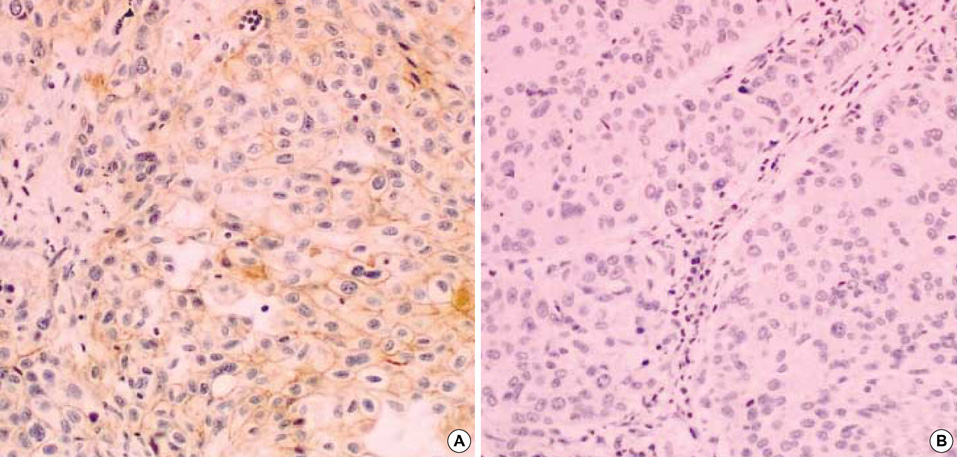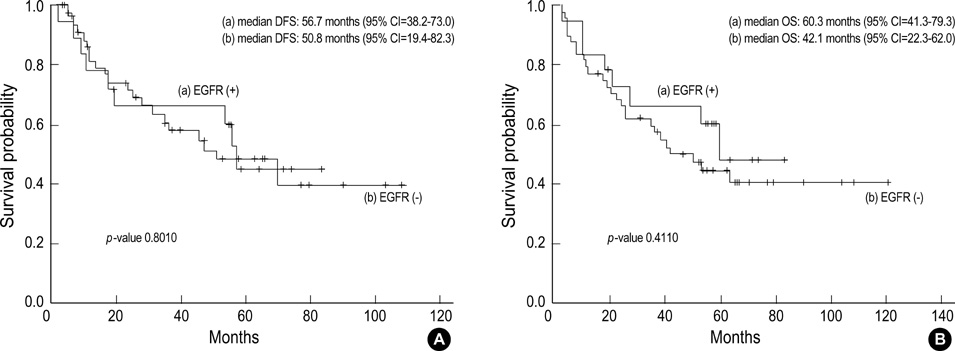J Korean Med Sci.
2004 Aug;19(4):529-535. 10.3346/jkms.2004.19.4.529.
Epidermal Growth Factor Receptor (EGFR) Expression in Operable Non-small Cell Lung Carcinoma
- Affiliations
-
- 1Department of Medicine, Asan Medical Center, University of Ulsan College of Medicine, Seoul, Korea. swkim@amc.seoul.kr
- 2Department of Pathology, Asan Medical Center, University of Ulsan College of Medicine, Seoul, Korea.
- KMID: 2157681
- DOI: http://doi.org/10.3346/jkms.2004.19.4.529
Abstract
- This study was performed to assay the expression of epidermal growth factor receptor (EGFR) in non-small cell lung carcinoma (NSCLC), and to investigate the relationship between EGFR status and various clinicopathologic features of NSCLC, including angiogenesis and proliferative activity. The expression of EGFR, microvessel count (MVC) measured by CD31 monoclonal antibody, and proliferative activity using Ki-67 labeling index were immunohistochemically analyzed in formalin-fixed and paraffin-embedded tissue specimens from 65 patients with completely resected stage II-IIIA NSCLC. Pathologic and clinical records of all patients were retrospectively reviewed. EGFR was expressed in 18 (28%) of 65 NSCLC samples. More squamous tumors (35%) were EGFR-positive than other NSCLCs (23%) (p-value 0.308). There was a statistically significant correlation between EGFR expression and Ki-67 labeling index (p-value 0.042), but no correlation was observed between EGFR expression and tumor histology, stage, or MVC. There were no differences between EGFR positive and negative tumors in 5-yr disease-free survival (60% vs. 52%, p-value 0.5566) and 5-yr overall survival (53% vs. 45%, p-value 0.3382) rates. In conclusion, our findings suggest that NSCLC proliferative activity may be dependent on EGFR expression, but that EGFR expression had no significant impact on survival in curatively resected NSCLC.
Keyword
MeSH Terms
Figure
Reference
-
1. Strauss GM, Kwiatkowski DJ, Harpole DH, Lynch TJ, Skarin AT, Sugarbaker DJ. Molecular and pathologic markers in stage I non-small cell carcinoma of the lung. J Clin Oncol. 1995. 13:1265–1279.2. Downward J, Yarden Y, Mayes E, Scrace G, Totty N, Stockwell P, Ullrich A, Schlessinger J, Waterfield MD. Close similarity of epidermal growth factor receptor and v-erb-B oncogene protein sequences. Nature. 1984. 307:521–527.
Article3. Schreiber AB, Libermann TA, Lax I, Yarden Y, Schlessinger J. Biological role of epidermal growth factor-receptor clustering: investigation with monoclonal anti-receptor antibodies. J Biol Chem. 1983. 258:846–853.
Article4. Sainsbury JRC, Nicholson S, Angus B, Farndon JR, Malcolm AJ, Harris AL. Epidermal growth factor receptor status of histological sub-types of breast cancer. Br J Cancer. 1988. 58:458–460.
Article5. Hendler FJ, Ozanne BW. Human squamous cell lung cancers express increased epidermal growth factor receptors. J Clin Invest. 1984. 74:647–651.
Article6. Yasui W, Sumiyoshi H, Hata J, Kameda T, Ochiai A, Ito H, Tahara E. Expression of epidermal growth factor receptor in human gastric and colonic carcinomas. Cancer Res. 1988. 48:137–141.7. Smith K, Fennelly JA, Neal DE, Hall RR, Harris AL. Characterization and quantitation of the epidermal growth factor receptor in invasive and superficial bladder tumors. Cancer Res. 1989. 49:5810–5815.8. Veale D, Kerr N, Gibson GJ, Harris AL. Characterization of epidermal growth factor receptor in primary human non-small cell lung cancer. Cancer Res. 1989. 49:1313–1317.9. Toi M, Nakamura T, Mukaida H, Wada T, Osaki A, Yamada H, Toge T, Niimoto M, Hattori T. Relationship between epidermal growth factor receptor status and various prognostic factors in human breast cancer. Cancer. 1990. 65:1980–1984.
Article10. Nicholson S, Richard J, Sainsbury C, Halcrow P, Kelly P, Angus B, Wright C, Henry J, Farndon JR, Harris AL. Epidermal growth factor receptor (EGFr); results of a 6 year follow-up study in operable breast cancer with emphasis on the node negative subgroup. Br J Cancer. 1991. 63:146–150.
Article11. Volm M, Drings P, Wodrich W. Prognostic significance of the expression of c-fos, c-jun and c-erbB-1 oncogene products in human squamous cell lung carcinomas. J Cancer Res Clin Oncol. 1993. 119:507–510.
Article12. Veale D, Kerr N, Gibson GJ, Kelly PJ, Harris AL. The relationship of quantitative epidermal growth factor receptor expression in non-small cell lung cancer to long-term survival. Br J Cancer. 1993. 68:162–165.13. Fujino S, Enokibori T, Tezuka N, Asada Y, Inoue S, Kato H, Mori A. A comparison of epidermal growth factor receptor levels and other prognostic parameters in non-small cell lung cancer. Eur J Cancer. 1996. 32A:2070–2074.
Article14. Fu XL, Zhu XZ, Shi DR, Xiu LZ, Wang LJ, Zhao S, Qian H, Lu HF, Xiang YB, Jiang GL. Study of prognostic predictors for non-small cell lung cancer. Lung cancer. 1999. 23:143–152.
Article15. Lee SW, Choi EK, Chung WK, Shin KH, Ahn SD, Kim JH, Kim SW, Suh C, Lee JS, Kim WS, Kim DS, Kim DK, Park SI, Sohn KH. Postoperative adjuvant chemotherapy and radiotherapy for stage II and III non-small cell lung cancer (NSCLC). Lung cancer. 2002. 37:65–71.
Article16. Horak ER, Leek R, Klenk N, LeJeune S, Smith K, Stuart N, Greenall M, Stepniewska K, Harris AL. Angiogenesis, assessed by platelet/endothelial cell adhesion molecule antibodies, as indicator of node metastases and survival in breast cancer. Lancet. 1992. 340:1120–1124.
Article17. Rusch V, Klimstra D, Venkatraman E, Pisters PWT, Langenfeld J, Dmitrovsky E. Overexpression of the epidermal growth factor receptor and its ligand transforming growth factor is frequent in resectable non-small cell lung cancer but does not predict tumor progression. Clin Cancer Res. 1997. 3:515–522.18. Dazzi C, Cariello A, Maioli P, Solaini L, Scarpi E, Rosti G, Lanzanova G, Marangolo M. Prognostic and predictive value of intratumoral microvessels density in operable non-small cell lung cancer. Lung cancer. 1999. 24:81–88.19. Hommura F, Dosaka-Akita H, Mishina T, Nishi M, Kojima T, Hiroumi H, Ogura S, Shimizu M, Katoh H, Kawakami Y. Prognostic significance of p27KIP1 protein and Ki-67 growth fraction in non-small cell lung cancers. Clin Cancer Res. 2000. 6:4073–4081.20. Fontanini G, Vignati S, Bigini D, Mussi A, Lucchi H, Angeletti CA, Pingitore R, Pepe S, Basolo F, Bevilacqua G. Epidermal growth factor receptor (EGFr) expression in non-small cell lung carcinomas correlates with metastatic involvement of hilar and mediastinal lymph nodes in the squamous subtype. Eur J Cancer. 1995. 31A:178–183.
Article21. Hendler FJ, Ozanne BW. Human squamous cell lung cancers express increased epidermal growth factor receptors. J Clin Invest. 1984. 74:647–651.
Article22. Veale D, Ashcroft T, Marsh C, Gibson GJ, Harris AL. Epidermal growth factor receptors in non-small cell lung cancer. Br J Cancer. 1987. 55:513–516.
Article23. Rusch V, Klimstra D, Linkov I, Dmitrovsky E. Aberrant expression of p53 or the epidermal growth factor receptor is frequent in early bronchial neoplasia, and coexpression precedes squamous cell carcinoma development. Cancer Res. 1995. 55:1365–1372.24. Dittadi R, Gion M, Pagan V, Brazzale A, Del Maschio O, Bargossi A, Busetto A, Bruscagnin G. Epidermal growth factor receptor in lung malignancies. Comparison between cancer and normal tissue. Br J Cancer. 1991. 64:741–744.
Article25. Pfeiffer P, Nexo E, Bentzen SM, Clausen PP, Andersen K, Rose C. Enzyme-linked immunosorbent assay of epidermal growth factor receptor in lung cancer: comparisons with immunohistochemistry, clinicopathological features and prognosis. Br J Cancer. 1998. 78:96–99.
Article26. Viberti L, Papotti M, Abbona GC, Celano A, Filosso PL, Bussolati G. Value of Ki-67 immunostaining in preoperative biopsies of carcinomas of the lung. Hum Pathol. 1997. 28:189–192.
Article27. Carpenter G, Cohen S. Epidermal growth factor. Ann Rev Biochem. 1979. 48:193–216.
Article28. Maurizi M, Almadori G, Ferrandina G, Distefano M, Romanini ME, Cadoni G, Benedetti-Panici P, Paludetti G, Scambia G, Mancuso S. Prognostic significance of epidermal growth factor receptor in laryngeal squamous cell carcinoma. Br J Cancer. 1996. 74:1253–1257.
Article29. Fischer-Colbrie J, Witt A, Heinzl H, Speiser P, Czerwenka K, Sevelda P, Zeillinger R. EGFR and steroid receptors in ovarian carcinoma: comparison with prognostic parameters and outcome of patients. Anticancer Res. 1997. 17:613–619.30. Mellon K, Wright C, Kelly P, Horne CH, Neal DE. Long-term outcome related to epidermal growth factor receptor status in bladder cancer. J Urol. 1995. 153:919–925.31. Inada S, Koto T, Futami K, Arima S, Iwashita A. Evaluation of malignancy and the prognosis of esophageal cancer based on an immunohistochemical study (p53, E-cadherin, epidermal growth factor receptor). Surg Today. 1999. 29:493–503.
Article32. Nicholson RI, Gee JMW, Harper ME. EGFR and cancer prognosis. Eur J Cancer. 2001. 37:S9–S15.
Article33. Tateishi M, Ishida T, Mitsudomi T, Kaneko S, Sugimachi K. Immunohistochemical evidence of autocrine growth factors in adenocarcinoma of the human lung. Cancer Res. 1990. 50:7077–7080.34. Selvaggi G, Novello S, Torri V, Leonardo E, De Giuli P, Borasio P, Mossetti C, Ardissone F, Lausi P, Scagliotti GV. Epidermal growth factor receptor overexpression correlates with a poor prognosis in completely resected non-small cell lung cancer. Ann Oncol. 2004. 15:28–32.35. Pfieffer P, Clausen PP, Andersen K, Rose C. Lack of prognostic significance of epidermal growth factor receptor and the oncoprotein p185HER-2 in patients with systemically untreated nonsmall cell lung cancer: an immunohistochemical study on cryosections. Br J Cancer. 1996. 74:86–91.36. Hirsch FR, Varella-Garcia M, Bunn PA Jr, Di Maria MV, Veve R, Bremmes RM, Baron AE, Zeng C, Franklin WA. Epidermal growth factor receptor in non-small cell lung carcinioma: Correlation between gene copy number and protein expression and impact on prognosis. J Clin Oncol. 2003. 21:3798–3807.37. Richardson CM, Sharma RA, Cox G, O'Byrne KJ. Epidermal growth factor receptors and cyclooxygenase-2 in the pathogenesis of non-small cell lung cancer: potential targets for chemoprevention and systemic therapy. Lung cancer. 2003. 39:1–13.
Article
- Full Text Links
- Actions
-
Cited
- CITED
-
- Close
- Share
- Similar articles
-
- Clinicopathologic Analysis of Epidermal Growth Factor Receptor Status in Non-small Cell Lung Cancer: Protein Expression, Gene Amplification and Survival Analysis
- Epidermal Growth Factor Receptor Expression of Non-small Cell Carcinoma and Its Relationship with Genomic Mutation
- A Case of Favorable Responses after Gefitinib in a Patient with EGFR Mutated Adenosquamous Lung Carcinoma
- Does the efficacy of epidermal growth factor receptor (EGFR) tyrosine kinase inhibitor differ according to the type of EGFR mutation in non-small cell lung cancer?
- Epidermal Growth Factor Receptor Expression and Cell Proliferation in Renal Cell Carcinoma



